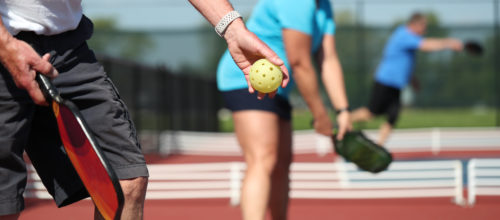
Pickleball Injury Prevention
Pickleball, a paddle sport that is a cross between tennis, racquetball and badminton, is the fastest-growing sport in the US. It is played on a smaller court and with a lower net and smaller racket than tennis, making it an excellent low impact exercise option. Pickleball has been specifically popular among older adults and has been shown to be beneficial in promoting physical fitness and social interaction. However, as with any sport, there is a risk for injury. Injuries can be more significant and debilitating as we get older, so it is important to understand how to play the game safely.
Potential Injuries
Potential pickleball injuries are similar to those in any racket sport and can be grouped into acute and chronic conditions.
Acute injuries can occur due to a sudden movement or trauma. Lateral movements, bending, pivoting and starting/stopping rapidly can contribute to ankle/knee ligament sprains, meniscus tears, and muscle strains in the lower body and back. Falling onto an outstretched arm can lead to wrist sprains or fractures of the wrist/arm. In addition, getting hit with the ball in the eye can result injuries ranging from cuts/lacerations and bruises to interocular bleeding and retinal detachment.
Chronic injuries are associated with repetitive movements/activity over time. Repetitive gripping and swinging of the racket can lead to tendon injuries in the wrists and epicondylitis of the elbows. Repetitive strain to the knees and ankles, especially the Achilles tendon, can develop into more chronic conditions. Plantar fasciitis, which is inflammation of the tissue in the heel, can be caused by repetitive pounding on the court.
How to Minimize Injury Risk
- Regular Exercise
- For general injury prevention, regular cardiovascular exercise outside of pickleball can help limit fatigue associated with play. Performing a regular exercise routine including cardiovascular, strength, and mobility training can keep you healthy both on and off the court.
- If you have a significant cardiovascular or pulmonary condition that limits your tolerance for exertion, you should consult with your physician prior to participating in pickleball or other exercise activities. Also, if you have a functionally limiting musculoskeletal problem such as severe osteoarthritis, you should be cautious when beginning pickleball to avoid exacerbating your condition.
- Warm Up
- Before any physical activity it is important to warm up and stretch. Take a brisk walk or light jog for 5-10 minutes and perform light, dynamic stretching for the muscles that will get used the most—hamstrings, hip flexors, quadriceps, glutes, calf, elbows and wrists.
- Protect Your Eyes
- Most eye injuries during sports are preventable. Using protective eyewear, particularly with polycarbonate lenses, is recommended for all racket sports.
- Proper Equipment
- Invest in proper footwear to help reduce your risk of lower extremity injuries. Court shoes, such as tennis shoes, allow you to move and glide easier on the court while also providing more lateral stability when compared to walking and running shoes.
- To minimize risk for wrist injuries and epicondylitis, consider selecting a lighter paddle and starting with a neutral grip. If your arm is feeling sore or fatigued half way through your game, your paddle may be too heavy.
- Protective taping and bracing of wrists and ankles may prove useful, especially in those with prior injury and chronic joint instability.
- Rest/Recovery
- It is important to give your body proper rest between games or practices. Eat right, hydrate, and get good sleep between playing sessions. Listen to your body and respect your physical limitations, if you are fatigued or sore, take a break.
- Follow the classic “pain rules” to exercise participation to avoid injury. Pain that worsens with activity, persists for >24 h after activity, or causes a gait change should alert you to modify activities and/or seek medical attention. This is especially important for older athletes and those with history of chronic, orthopedic conditions.
If you do experience pain or injury associated with pickleball, reach out to one of our physical therapists for evaluation and treatment!
References:
Greiner N. Pickleball: Injury Considerations in an Increasingly Popular Sport. Mo Med. Nov-Dec 2019; 116(6): 488–491.
Vitale K, Liu, S. Pickleball: Review and Clinical Recommendations for this Fast-growing Sport
Current Sports Medicine Reports: October 2020; 19(10): 406-413.
https://www.brettgilbertmd.com/pickleball-injuries-5-tips-to-avoid-getting-hurt/
